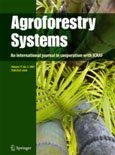Retaining trees in low-input agroecosystems could be key to maintain mycelia of arbuscular mycorrhizal fungi (AMF) and hence, improve soil fertility and crop performance. We assessed the impact of faidherbia (Faidherbia albida, Fabaceae) and mango (Mangifera indica, Anacardiaceae) trees on AMF and soil fertility in smallholder farmers’ maize fields. Along distance-from-tree gradients (1, 4, 10, 15 m), we collected soil to assess AMF hyphal density, soil aggregation, and aggregate-associated carbon (C), nitrogen (N), and phosphorus (P) at the end of the non-cropping season. Further, we determined maize biomass and yield. The impact of faidherbia on maize N nutrition was assessed using the 15N natural abundance methodology. Our results show that hyphal density was largest at 4 and 10 m from trees and greater around faidherbia than mango. Soil aggregation decreased with distance from mango and was greater around faidherbia than mango. Macroaggregate-associated C, N, and P decreased with distance-from-tree, due to differences in aggregate distribution. Maize biomass was smallest at 1 m from trees and did not differ when under faidherbia versus mango. On average 69 ± 14, 24 ± 9, 20 ± 6, and 12 ± 5% of total foliar N of maize grown at 1, 4, 10, and 15 m from faidherbia trees was tree-derived. Our results suggest that faidherbia and mango trees can maintain AMF mycelia and combat declining soil fertility. Faidherbia is particularly suited to enhance measured soil parameters commonly associated with soil fertility and alleviate soil mining for N via improved internal N cycling. As such, agroforestry trees can contribute to a more sustainable agriculture positively affecting the environment via mitigating soil degradation. © 2021
DOI:
https://doi.org/10.1016/j.agee.2021.107487
Altmetric score:
Dimensions Citation Count:























